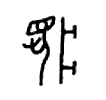Shell Bone Script of character Dream
On the left is a person, and on the right is a bed. Shell bone script was written on bamboo slips, which were very narrow, making horizontal writing difficult. Hence, many characters are written vertically, such as tiger (虎), horse (馬), dog (犬), pig (豕), elephant (象), etc.
Some might ask, "Weren't shell bone scripts written on shell bones? How can you say they were written on bamboo slips?" The discovered shell bone scripts are indeed carved on bones because only bones can withstand over more three thousand years of weathering and remain intact. Bamboo slips would have long decayed and not survived. Similarly, bronze inscriptions (金文) survived because their metal vessel carriers could remain intact, whereas those written on bamboo slips did not.
The Big Seal Script of character Dream
At the top are eyebrows, in the middle is an eye, and the curved strokes represent a person's body. Below is the character "夕" (xi), meaning the evening when the sun has set, it’s dark, and time to sleep. Here, the bed is omitted.
The Small Seal Script of character Dream
The eyebrows at the top look like the radical for grass (艹). Next is the horizontal "目" (eye). The body below encloses the "夕" (evening) character, fulfilling the symmetry of the small seal script but losing its pictographic nature.
The Clerical Script of character Dream
Since the small seal script wrote the eyebrows like the grass head, the clerical script is similar, the top is the grass head. Below is the horizontal eye, and the body resembles a semi-covered person (though no longer looking like one), with the "夕" below.
The Simplified Chinese of character Dream
At the top is "林" (forest), and at the bottom is "夕." How this simplification came about is unknown. Some believe it derived from cursive script. However, after checking cursive script, this does not seem to be the case. It’s possible that an individual wrote it this way, and a simplification expert adopted it. But standardized cursive script certainly does not write it this way.
Now, let's look at the character Illusion.
The Bronze Script of character Illusion (no oracle bone script found)
A tree branch hangs with a spider web. After the rain, the web appears to change colors in the sunlight.
The Big Seal Script of character Illusion
Similar to the bronze script.
The Small Seal Script of character Illusion
The tree branch turns into a small handle, and the spider web becomes two overlapping triangles.
The Clerical Script of character Illusion
The left radical is a twisted silk thread representing the spider web, and the right radical is the tree branch. This script actually resembles the bronze and large seal scripts more than the small seal script. Regular script and Song typeface have hardly changed in two thousand years.
In conclusion, while the characters "dream" and "illusion" have evolved over millennia, their origins provide fascinating insights into ancient Chinese writing and the preservation of meaning through various script styles.













No comments:
Post a Comment